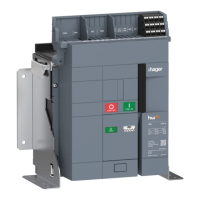72 6LE008146B
Advanced protection functions
5.6 Reverse active power protection (RP-32R)
The reverse active power protection (RP-32R), ANSI 32R detects when a synchronous power
generator connected in parallel to other sources is functioning as a synchronous motor.
It enables the circuit breaker to be tripped to disconnect the generator from other sources or it
can also be used to monitor the active power exchanged between two sources and generate
an alarm to take a load-shedding measure or to trip once the flow coming back from the active
power exceeds the fixed value.
Operating principle
The reverse active power protection is based on the measurement of the internal sensors of
the hw+ sentinel Energy circuit breaker.
The power sign convention parameter must be set in accordance with the direction of the
circuit breaker's power supply, from the top or bottom. This allows the power sign to be
assigned correctly, which must be positive in the direction of the power supply towards the
load. By default, the power sign convention parameter is set to positive which is valid for the
power source connected from the top of the circuit breaker.
If the power source is connected from the bottom of the circuit breaker, this parameter must
be set to negative.
This is necessary for the reverse active power protection to work correctly.
It starts when the total active power reaches the negative value of the activation threshold and
when the activation time delay has elapsed.
In order to avoid unwanted tripping, the RP-32R protection only activates if the power factor is
very weak, i.e. if:
|Q/P| > 32 (88.2° < φ < 91.8° or 268.2° < φ < 271.8°).
The diagram below illustrates the case where RP = 1000 kW.
- RP
Non-tripping

